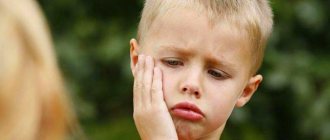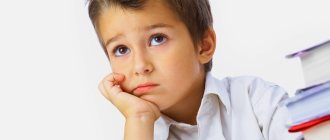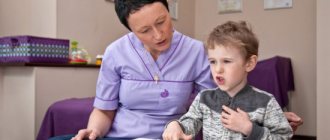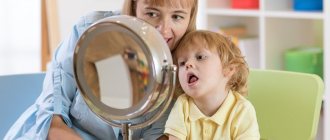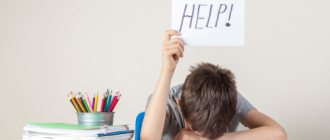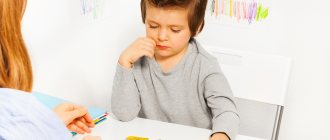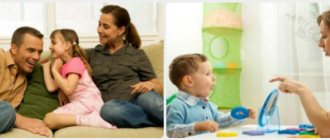Main reasons
The causes of the disease can be:
- Pathology of intrauterine development: maternal illnesses, injuries;
- Genetic predisposition;
- Complications during childbirth: hypoxia, infection;
- Head injuries;
- Poisoning with toxic substances.
Risk factors for the development of motor alalia may be frequent illnesses in children in the first years of life, surgical interventions under general anesthesia, insufficient speech contacts, as well as pedagogical neglect.
Causes and risk factors
Children with motor alalia are usually born with this pathology. The causes most often are various injuries and pathological processes that occur during the intrauterine development of the child. During pregnancy the following can cause harm:
- alcohol;
- sudden changes in hormonal levels;
- infections;
- falls and injuries;
- placental abruption;
- depression, constant stress.
Alalia can also cause problems in the first years of a child’s life. Brain damage is caused by:
- weak contractions and unsuccessful birth;
- breathing problems immediately after birth, due to which the brain does not receive enough nutrition;
- severe hypothermia of the newborn.
The disease can also develop after suffering from rubella, meningoencephalitis, severe head injuries and bruises, and due to somatic pathologies.
Symptoms
Motor alalia is characterized by the presence of both non-speech and speech symptoms. Non-speech manifestations of pathology, first of all, include motor disorders such as insufficient coordination of movements, clumsiness, and poor development of motor skills of the fingers.
Motor alalia in a child may also be accompanied by difficulties in developing self-care skills, such as tying shoes or buttoning buttons. Also in performing precise small movements with the hands and fingers: folding puzzles, construction sets and mosaics.
Also, children with motor alalia often have disorders of memory, perception, attention, emotional and volitional spheres of personality. Both hyperactive and hypoactive behavior are observed. There is rapid fatigue and decreased performance. In addition, patients with alalia often experience disturbances in the movements of the facial muscles, increased irritability and aggression, and poor adaptation to the conditions of the surrounding world.
Speech symptoms of motor alalia in patients include:
- erroneous replacement of sounds in words with others;
- loss of sounds from words;
- persistent repetition of a word or phrase;
- limited vocabulary;
- combining syllables of different words;
- replacing words with ones that are similar in meaning or sound;
- loss of prepositions from a phrase, incorrect agreement of words in a phrase.
The vocabulary of a patient with alalia is significantly poorer than the age norm. The patient has difficulty learning new words; the active vocabulary consists largely of words and phrases of everyday use. Insufficient vocabulary can lead to misunderstanding of the meaning of a word and inappropriate use of words.
Patients with alalia, as a rule, express themselves in simple short sentences, which leads to a gross disruption of the formation of coherent speech in the child. Patients have difficulties in determining cause and effect, main and secondary, temporary connections, conveying the meaning of events, and presenting them sequentially.
In some cases, with motor alalia, the child has only onomatopoeia, babbling words, the use of which is accompanied by active facial expressions and gestures.
Features of the disorder, characteristic signs
The disorder has a number of symptoms:
- understanding of someone else's speech is preserved;
- the patient’s fluency of speech is impaired;
- articulation disorders are noted;
- the formation of expressive speech is upset;
- left-handedness is common;
- speech praxis—the ability to reproduce sounds—suffers.
If a child has motor alalia, the corrective work of a speech therapist will help to restore the necessary functions. In the case of alalia, we are not talking about a complete cure, but it is possible to achieve compensation of functions - to make sure that the child is able to pronounce the necessary sounds. You will also need the help of other specialists.
Diagnostics
To diagnose motor alalia, it is necessary to examine the child by a pediatric otolaryngologist, neurologist, speech therapist, or psychologist.
When conducting a speech therapy examination of a child, considerable attention is paid to collecting a perinatal history and the characteristics of the patient’s early development. To diagnose motor alalia, it is necessary to assess the child’s desire to speak, determine the presence of difficulties in repeating what he heard, auditory perception, active use of facial expressions and gestures, perception and understanding of speech, and the presence of echolalia. In addition, the level of active and passive vocabulary, syllabic structure of words, pronunciation of sounds, grammatical structure of speech and phonemic perception are noted.
To assess the severity of brain damage, electroencephalography, echoencephalography, magnetic resonance imaging of the brain, and x-ray examination of the skull may be required. For differential diagnosis with sensory alalia and hearing loss, audiometry, otoscopy and some other methods of studying auditory function are used. Differential diagnosis with dysarthria, autism, mental retardation, and delayed speech development is required.
Forms of motor alalia in children
There are two types of motor alalia - afferent and efferent.
Afferent
This form is caused by lesions in the areas of the cerebral cortex responsible for controlling speech programs. This area is located in the left hemisphere, namely in its inferior parietal part. With this form of alalia, it is difficult for a child to pronounce words and find the correct articulatory postures. In other words, it is difficult for a child to find the correct position of the tongue, lips, jaws to produce a particular sound. This phenomenon is called oral-articulatory apraxia in the scientific medical literature. Afferent motor alalia is characterized by distortion of sounds and word structure.
Efferent form of motor alalia
This form occurs when Broca's center is affected. It is located in the posterior frontal part of the brain. This area is responsible for switching individual articulatory acts. Children with this diagnosis do not observe the correctness and order of articulatory movements, and speech inhibition is noticeable. This is called kinetic apraxia. Motor alalia is also classified into three levels:
- First level. The child's speech is very limited, he uses a few words, and his speech consists of onomatopoeia and primitive babble.
- Second level. The vocabulary is of medium size, the baby can construct short phrases and sentences.
- Third level. The child has phrasal speech.
Treatment
Treatment of motor alalia is complex. The formation of speech skills is carried out against the background of drug therapy, the main purpose of which is to stimulate the maturation of brain structures.
Patients are prescribed nootropic drugs and vitamin complexes. Electrophoresis, magnetic therapy, laser therapy, decimeter wave therapy, transcranial electrical stimulation, acupuncture, electropuncture, and hydrotherapy are effective.
An important role in the treatment of motor alalia is given to the development of the child’s gross (gross) and manual (fine) motor skills, as well as memory, thinking, and attention.
Speech therapy correction of motor alalia includes work with all aspects of speech and includes not only classes with a speech therapist, but also regular specially selected exercises at home. At the same time, the child’s active and passive vocabulary is formed, work is carried out on phrasal speech, grammar, sound pronunciation, and coherent speech develops.
Speech therapy massage and logorhythmic exercises provide good results. With motor alalia, it is recommended to start teaching children to read and write early, since reading and writing help control oral speech and better consolidate the learned material.
Sensory alalia
With sensory alalia, the perception of other people's speech is impaired due to damage to the speech-hearing analyzer. Sensory alalia is very rare, perhaps due to imperfect diagnostics.
Features of the pathology:
- Many children with this pathology do not even respond to their own name and do not understand speech addressed to them.
- Children may understand individual words but lose the meaning of statements with the same words.
- In other cases, they understand the instructions for completing the task, but outside of this situation they cannot understand the task.
- Sometimes he incoherently repeats words he knows - logorrhea develops.
Information reaches children's brains in fragments, because they perceive it very poorly by ear. This results in incomprehensible, distorted speech, although the speech activity of such children is quite high.
Realizing their defect, many children become shy, although they do not lose the desire to communicate. Other alaliks are excitable and irritable, and may exhibit negativism and affective outbursts.
In some cases, a complex disorder is diagnosed - sensorimotor alalia.
Silence mode when correcting sensory alalia
The speech therapist recommends to parents how to properly organize the baby’s speech and sound modes. Temporarily, adults are asked to talk to the child as little as possible, organizing a quiet hour or a hearing rest day. During this time, it is necessary to eliminate unnecessary sounds in the children's room: a playing TV, a computer, a tablet; sometimes it is recommended to remove sounding visual stimuli (toys, books). This sound mode helps to increase children's sensitivity to sounds.
The next stage is the awakening of interest in the sounds surrounding the child, the emergence of interest in imitation and perception of one’s own speech.
In the first lessons, the speech therapist develops attention, helping the child to focus on sound stimuli, teaching him to distinguish between two or three sounding objects, for example, a pipe, a tambourine and spoons. Then he is given the opportunity to play various games that will help him develop correct, smooth, diaphragmatic breathing.
At the next stage of correction, the speech therapist’s main task is to draw the child’s attention to laughter, crying and other reactions of people around him, to develop perseverance and the ability to copy the emotional reactions of others. If he is tired, the lesson stops. For the work of a speech therapist to be successful, correction is carried out from 2.5-3 years. The specialist must systematically influence each component of speech.
Prognosis and prevention
With properly organized and carefully carried out work to correct motor alalia, it is possible to almost completely compensate for this defect by the beginning of schooling and overcome the danger of further speech and intellectual underdevelopment. But such children have a high risk of developing dysgraphia and dyslexia during their schooling. Children with complex damage to brain structures or for whom correctional work began late will not be able to overcome this pathology of speech development. Therefore, in the future they are sent to special schools to continue correctional work.
To prevent the appearance of such a complex pathology, it is necessary to carefully screen the health status of pregnant women, rationally manage childbirth, and protect children from contracting neuroinfections and injuries.
That's all. Now you know how the forms of alalia differ and how to treat it, and whether this disorder can be cured without the services of specialists.
Massage technique
When treating alalia, speech therapy massage is very effective, stimulating speech zones. A full massage cannot be performed without qualifications and the use of special probes. Under the guidance of a specialist, parents can learn the simplest techniques of massaging the face, hands, lips, tongue and carry them out at home on their own. To do this, you can use teaspoons with smooth edges and your mother’s clean, warm hands. Elements of the massage are performed 5 times, all exercises begin and end with stroking.
Sequence of massage movements:
- stroking the forehead from the center to the temples, temples clockwise using the convex side of a spoon or hands;
- the eye sockets are ironed in the same way;
- cheeks are stroked in a circle;
- then the space between the eyebrows is massaged;
- The nose is rubbed, the lip and tongue are massaged.
Hand and face massage is carried out in a warm room. The massage therapist's hands are pre-treated with an antiseptic.
By massaging a child's hands, he develops fine motor skills associated with brain function and speech. It can be performed not only with your hands, but also with rubber balls, prickly curlers, Su Jok. Hand warm-up begins with the little finger, first from its outer side. Then it is recommended to move up along the finger, gently pressing on the pads, then rubbing them. After warming up the palm, its inner side is massaged.
